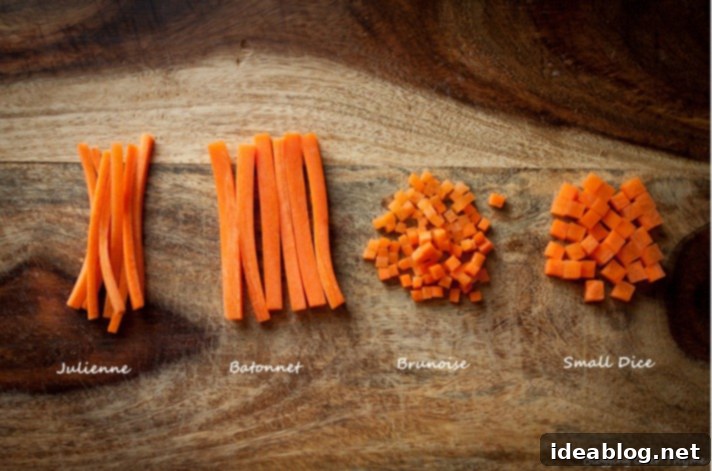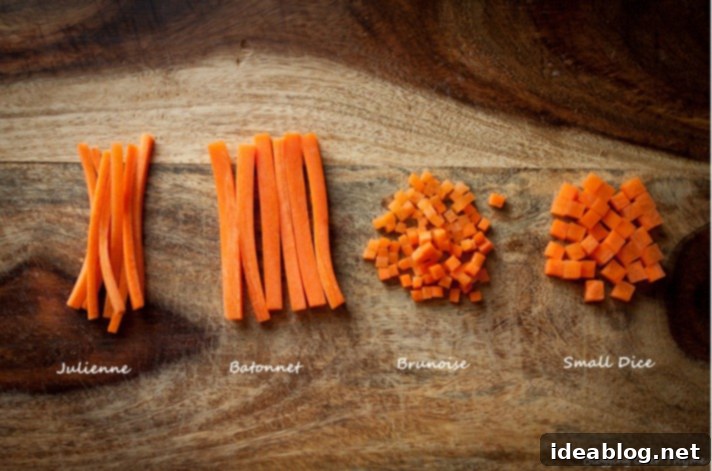Culinary School Chronicles: Mastering Knife Skills, Tourneeing Potatoes, and Acing My First Big Exam
The rhythmic sound of my chef’s knife hitting the cutting board echoes through my kitchen. It’s late, but my focus is singular: practicing my knife skills to perfection. This isn’t just a casual cooking session; it’s an intensive preparation for my first major practical and theory exam, which is a mere tomorrow away! The aroma of fresh produce fills the air, mingling with the subtle scent of impending pressure and undeniable excitement. Every precise cut, every carefully shaped vegetable, brings me closer to the demanding standards of professional culinary arts.
Right now, I’m deep in the trenches of perfecting one of the most elegant and challenging classic French techniques: tourneeing potatoes. This marks my third bag of potatoes in just two days, a testament to the repetitive yet rewarding practice required to achieve culinary precision. Each potato is a small canvas, and my goal is to transform it into a symmetrical, seven-sided, barrel-shaped masterpiece. Simultaneously, I’m poring over textbooks and notes, cramming for the theory portion of my exam, hoping all my dedication culminates in success.
The Foundation of Culinary Excellence: Mastering Knife Skills
In the demanding world of professional cooking, knife skills are paramount. They are not merely about cutting food; they embody efficiency, safety, and the ultimate quality of a dish. Our instructors emphasize that consistent, precise cuts ensure even cooking, enhance presentation, and minimize waste – all critical factors in any high-volume kitchen. My current focus is on achieving uniformity across a variety of fundamental cuts: the fine julienne, the tiny brunoise, the various sizes of dice, and the sturdy batonnet.

Each cut has specific dimensions that must be adhered to with meticulous accuracy. For example, a perfect julienne of carrots should measure 1/8 inch by 1/8 inch by 1-2 inches. Deviating from these measurements, even slightly, can drastically impact the final texture and visual appeal of a dish. Imagine a medley of vegetables where some pieces are mushy from being overcooked while others remain stubbornly raw – that’s the consequence of inconsistent knife work. This understanding drives my relentless pursuit of perfection.
Beyond the Cut: Safety and Tool Maintenance
Mastering the blade extends far beyond just shaping food. It encompasses proper knife grip, maintaining a confident and stable posture, and the indispensable “claw” technique to safeguard my non-dominant hand. Holding the knife correctly – with a firm yet relaxed grip that balances the blade and handle – provides maximum control and reduces fatigue during long prep sessions. The “claw” is my second line of defense, tucking my fingertips safely away as the blade glides past my knuckles. It’s a finely tuned coordination, where vigilance is key to preventing painful accidents.
Equally vital is the art of knife maintenance. A sharp knife is not just efficient; it’s a safer tool. It requires less force, reducing the chance of slips and increasing control. I’ve ingrained the habit of honing my knife regularly with a steel and diligently sharpening it with a whetstone when the edge truly dulls. This meticulous care ensures my tools are always performing at their peak, allowing me to execute clean, precise cuts with ease and confidence. It’s a fundamental part of respecting the craft and ensuring kitchen safety.
The Elegance of Simplicity: The Art of Tourneeing Potatoes
The tournee potato is a symbol of classical French culinary artistry. It transforms a humble potato into an exquisite, barrel-shaped masterpiece with seven perfectly uniform sides. This technique is often seen in fine dining, accompanying roasted meats or gracing sophisticated dishes like Pommes Château. It’s not just about aesthetics; the consistent shape ensures each potato cooks evenly, reaching the ideal tenderness simultaneously, enhancing both the look and the taste of the dish.
My kitchen counter has been graced by what feels like a small mountain range of potatoes these past two days. I typically select large, firm Russets, aiming for a consistent two-inch length and those seven distinct facets. While it sounds deceptively simple, achieving that perfectly smooth, symmetrical shape without excessive waste is surprisingly demanding. Every potato presents a unique challenge, and the goal is to work swiftly and confidently, allowing the paring knife to carve thin, even strips of peel to form the desired shape. This process requires not only skill but also a keen eye for geometry and spatial reasoning.
My initial attempts were, to put it mildly, less than perfect. Many were lopsided, scarred with errant cuts, or dwindled to an unacceptably small size. However, with each successive potato, I feel my hand growing steadier, my technique becoming more refined, and my understanding of the potato’s natural form deepening. It’s a surprisingly meditative and immersive process, demanding intense focus and a significant amount of wrist dexterity. My culinary mentors often say that the ability to flawlessly tournee a potato is a true hallmark of a skilled culinarian, a testament to patience, persistence, and unwavering attention to detail. This technique feels like a culinary rite of passage, and I am absolutely determined to master it.
The Culinary School Exam Tomorrow: A Dual Challenge
Tomorrow marks a monumental occasion: my first comprehensive practical and theory exam. The pressure is immense, as this assessment encapsulates weeks of intensive learning, ranging from the most fundamental knife skills to intricate cooking theories. The practical portion will rigorously test my ability to perform various cuts under the watchful eyes of my instructors. I anticipate being required to swiftly and accurately julienne carrots, brunoise onions, dice potatoes, and, crucially, flawlessly tournee a selection of vegetables – all within a strict time limit. Consistency, speed, minimal waste, and proper technique will be the critical benchmarks for success.
Beyond the sheer technical execution, the practical exam also evaluates my mastery of mise en place – the foundational organizational process of meticulously preparing all ingredients and tools before any cooking begins. This includes demonstrating impeccable sanitation practices, efficiently setting up my workstation, and exhibiting a logical, streamlined workflow. It’s about showcasing not just my manual dexterity, but also the disciplined mindset and methodical approach that are absolutely essential in a high-pressure professional kitchen environment. Every detail counts, from the cleanliness of my station to the strategic placement of my tools.
Navigating the Theory: Understanding the “Why” Behind the “How”
The theory exam presents an equally formidable intellectual challenge. It covers an expansive spectrum of culinary knowledge: stringent food safety and sanitation protocols (HACCP principles are drilled into us daily), a vast lexicon of classical French culinary terms and techniques, foundational nutrition principles, precise ingredient identification, and the underlying science of various cooking methods. Understanding the “why” behind every culinary action is just as crucial as mastering the “how.” For instance, knowing the scientific principles of emulsification, the ideal temperatures for protein coagulation, or the chemistry of flavor development is vital for achieving consistently excellent and predictable results.
I’ve invested countless hours poring over dense textbooks, flipping through stacks of flashcards, and meticulously reviewing my extensive notes, striving to commit every piece of information to memory. The sheer volume of material can often feel overwhelming, but I constantly remind myself that this deep theoretical knowledge forms the intellectual backbone of true culinary artistry. It transcends mere memorization; it’s about internalizing these principles so they become intuitive, guiding my decisions and techniques effortlessly when applied in a real cooking scenario. This holistic understanding is what transforms a cook into a true chef.
The Journey Ahead: Anticipation, Dedication, and the Next Chapter
The culmination of these intense practice sessions and late-night study marathons will be put to the ultimate test tomorrow. I’ll be back with a comprehensive update on today’s rather fabulous menu – which I’m eager to describe, assuming I manage to keep my composure and not set anything ablaze amidst the exam nerves! And, of course, I’ll provide all the behind-the-scenes scoop on how the exam unfolded, detailing the specific challenges I faced and, hopefully, the triumphs I celebrated.
This culinary journey is undeniably demanding, pushing my limits physically and mentally, yet it is also incredibly fulfilling. Every perfectly executed cut, every smoothly turned potato, and every complex culinary concept that clicks into place brings me closer to realizing my dream of becoming a truly skilled and respected chef. The path is long, but my resolve is unwavering. Here’s hoping all the diligent practice, exhaustive studying, and sheer passion pay off in a big way tomorrow. Wish me the very best of luck!
